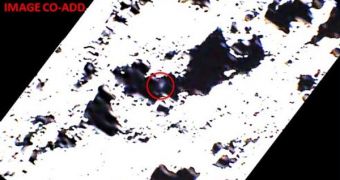Over the past week, debate has raged on whether or not scientific observations of the plume emitted by the Centaurus upper rocket stage upon slamming into the Moon last Friday will be visible or not. Some have argued that the calculations on which the mission was founded were flawed, while others said that the instruments aboard the $79-million Lunar CRater Observation and Sensing Satellite (LCROSS) surely must have picked something up, and finding it was just a question of browsing available data.
The latter group appears to have been correct in their arguments. Officials at the American space agency have just announced that the first images showing the debris plume ejected by the impacting upper stage have been found, and are currently being analyzed. The faint signature of the 3.7- to 5-mile (6- to 8-kilometer) tall ejecta has been detected by both of the spacecraft's mid-infrared (MIR) thermal cameras, its ultraviolet/visible and near infra-red spectrometer, as well as its Visible Light Camera, Space reports.
“The images of the floor of Cabeus are exciting. Being able to image the Centaur crater helps us reconstruct the impact process, which in turn helps us understand the observations of the flash and ejecta plume. Within the range of model predictions we made, the ejecta brightness appears to be at the low end of our predictions and this may be a clue to the properties of the material the Centaur impacted,” LCROSS principal investigator and project scientist Anthony Colaprete said.
Various traits of the debris plume also offer data about its place of origin, the Cabeus crater at the lunar south pole. In addition to (maybe) discovering water in the ejecta material, scientists can also determine several other features of Cabeus by looking at the magnitude, form, and visibility of the plume. In its very last few seconds before slamming into the Moon, LCORSS photographed what appeared to be a 92-foot (28-meter) wide crater, generated by Centaurus.
The thermal and near-infrared cameras, which literally transmitted data until the last second, photographed the impact site at a resolution of less than 6.5 feet (2 meters), which is extremely accurate. “We are blown away by the data returned. The team is working hard on the analysis and the data appear to be of very high quality,” Colaprete added.

 14 DAY TRIAL //
14 DAY TRIAL //